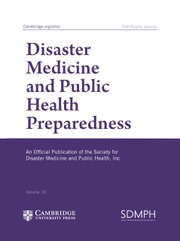No CrossRef data available.
Article contents
Does Disaster Severity Have a Long-Term Effect on Survivors’ Disaster Preparedness? A Survey a Decade after the 2008 Wenchuan Earthquake in China
Published online by Cambridge University Press: 09 September 2024
Abstract
Disaster experiences have long-term effects on disaster preparedness. This study examined the long-term (10-y) effect of disaster severity of the 2008 Wenchuan earthquake on survivors’ disaster preparedness and the moderating effects of household vulnerability.
The data were collected in January 2018 covering 30 counties in Wenchuan earthquake-stricken areas. The dependent variable was survivors’ disaster preparedness (including overall, material, knowledge and awareness, and action preparedness) in 2018. Disaster severity included survivors’ housing damage and county death rate caused by the earthquake in 2008. Household vulnerability is a set of conditions that negatively affects the ability of people to prepare for and withstand disaster, proxied by households’ per-capita income and the highest years of schooling of household members. We performed multivariable linear regression models to answer the research questions.
A higher county death rate was associated with better overall preparedness (β = 0.043; P < 0.05) and knowledge and awareness preparedness (β = 0.018; P < 0.05), but housing damage was not significantly associated with disaster preparedness. The positive association of county death rate with overall preparedness (β = −0.065; P < 0.05) becomes weaker when a household has a higher per-capita income. Also, with the household per-capita income increasing, the associations of county death rate with material preparedness (β = −0.037; P < 0.05) and action preparedness (β = −0.034; P < 0.01) become weaker.
Disaster severity has positive and long-term effects on survivors’ disaster preparedness. Also, the positive and long-term effects are affected by household vulnerability. Specifically, the positive and long-term effects of disaster severity on disaster preparedness are more substantial when a household is more vulnerable.
Keywords
- Type
- Original Research
- Information
- Copyright
- © The Author(s), 2024. Published by Cambridge University Press on behalf of Society for Disaster Medicine and Public Health, Inc


